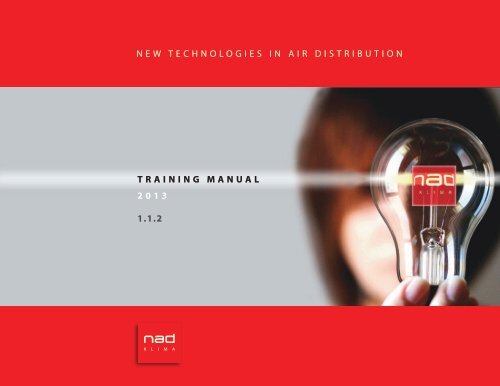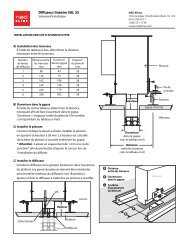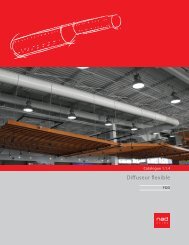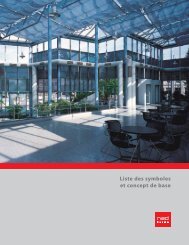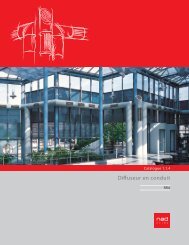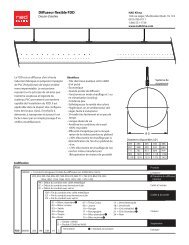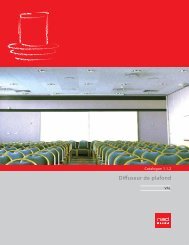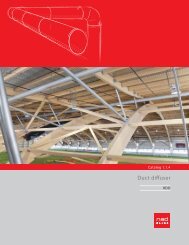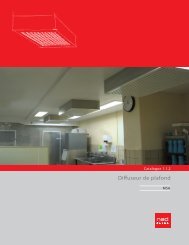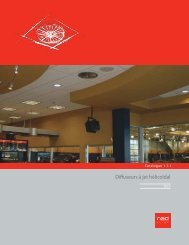Training Manual - NAD Klima
Training Manual - NAD Klima
Training Manual - NAD Klima
You also want an ePaper? Increase the reach of your titles
YUMPU automatically turns print PDFs into web optimized ePapers that Google loves.
N E W TECHNO L O GIES IN A I R D I S T R I BUT I O N<br />
T R AINING M A N U A L<br />
201 3<br />
1.1.2
In 1988, Daniel Lauzon based Danco Télévac Group, a company<br />
specialized in balancing and cleaning ventilation systems.<br />
research, Mr. Lauzon introduces the most complete range of air<br />
of North America.<br />
Our challenge is to establish a relationship<br />
balancing aspects of performance and savings while<br />
enhancing the standards excellence<br />
of our products to improve<br />
quality of life of users. "<br />
Daniel Lauzon<br />
president<br />
Today <strong>NAD</strong> <strong>Klima</strong> produces locally and distributes throughout North<br />
Since then, <strong>NAD</strong> <strong>Klima</strong> is constantly innovating. The company is proud<br />
of many achievements developed with contractors, engineers and<br />
architects.<br />
ment of comfort, air quality and used for the economy of energy.<br />
-<br />
We are <strong>NAD</strong> <strong>Klima</strong>.<br />
<strong>NAD</strong> <strong>Klima</strong> is a member of the Canadian Green Building Council
Section 1.1<br />
COMFORT FACTORS<br />
Basic principle on air movement<br />
Ventilation by mixing<br />
Induction diffuser<br />
Standard diffuser<br />
• The air helical movement creates a movement of rotation at the output of the diffuser<br />
• It allows an aspiration of the air from the center of the room to the diffuser
Section 1.2<br />
COMFORT FACTORS<br />
Basic principle on air movement<br />
Ventilation by displacement<br />
Diffusion<br />
from bottom to top<br />
Diffusion<br />
from top to bottom<br />
- - - - - - - - -<br />
//////////
Section 1.3<br />
COMFORT FACTORS<br />
The induction trajectory of the air and Coanda effect<br />
Isothermal air flow<br />
Non isothermal air flow<br />
Warm air<br />
22°<br />
Air Flow<br />
front view<br />
Cold air<br />
Coanda effect from the wall<br />
30cm Max.<br />
Coanda effect from the ceiling<br />
Max.<br />
45°<br />
Min.
Section 1.4<br />
COMFORT FACTORS<br />
Air velocity<br />
<strong>NAD</strong> <strong>Klima</strong> diffuser<br />
• The air at the output is mixed with<br />
the air of the room<br />
• It will reach the occupied zone with<br />
very low speeds of about 30 fpm<br />
• The <strong>NAD</strong> induction divides by 3 the<br />
speed of the air in the occupied zone<br />
9 ft<br />
Human<br />
height<br />
6 ft<br />
12˚C<br />
Crossing of<br />
two jets of air<br />
12˚C<br />
Comfort level<br />
Thermostat<br />
5 ft<br />
• The air will be approximately induct<br />
15 to 18 times to the occupied zone<br />
compared to 4 to 6 times with a standard diffuser .
Section 1.5<br />
COMFORT FACTORS<br />
Temperature difference<br />
12˚C<br />
12˚C<br />
Comfort level<br />
Human height<br />
6 ft (1.8 m)<br />
∆To = Tr -To<br />
10 = 22 - 12<br />
22˚C<br />
∆Txy = Tr -Txy<br />
2.5 = 22 - 19.5 (standard)<br />
0.6 = 22 - 21.4 (<strong>NAD</strong>)<br />
∆Txy<br />
∆To<br />
∆Txy<br />
∆To<br />
= 0.25 (standard)<br />
= 0.06 (<strong>NAD</strong>)<br />
Thermostat<br />
5 ft<br />
(1,4 m)<br />
9 ft<br />
- The <strong>NAD</strong> induction reduces the temperature difference in the occupied zone by 15 to 18 times.<br />
- The temperature difference at the output of the diffuser: 10°C<br />
- The temperature difference in the occupied zone : 0.6°C with high induction compared<br />
to 2.5°C with standard diffusion.
Section 1.6<br />
COMFORT FAC TORS<br />
The sound level<br />
connec tion on diffuser.<br />
• 80% of the air volume passes through 20% of<br />
the sur face<br />
• A diversion of the connec tion of more than<br />
half a times the diameter will increase by 12<br />
to 15 (dB) the sound level.<br />
• The majority of the nor th american<br />
manufac turers consider that 10 decibels (dB)<br />
are absorbed by the while europeans consider<br />
a sound level net in the occupied area.<br />
• Ex tremely quit diffuser<br />
• I nstallation of plenum per forated plate :<br />
- Allows the blooming of air by reducing the<br />
air speed<br />
- On the inside, a per forated plate is to<br />
already reduced by the plenum)<br />
• Eccentric c ylinders<br />
to the eccentric c ylinders.<br />
(b)<br />
2’<br />
80%<br />
of air<br />
20%<br />
in cooling
Section 1.7<br />
COMFORT FACTORS<br />
The humidity level<br />
Dehumidification of the new air, DAL 358 diffusers<br />
12˚C<br />
22˚C<br />
Thermostat<br />
26 fpm , DT = 0,3°C<br />
(21.7°C)<br />
EVAPORATORS<br />
humid air<br />
dry coil<br />
start of condensation<br />
8 to 10 min.<br />
evacuation of the<br />
water of condensation<br />
± 7 min.<br />
evacuation of the<br />
water on the coil<br />
2 to 5 min.<br />
dry coil<br />
Compressor<br />
“ OFF ”<br />
Compressor<br />
“ ON ”<br />
Compressor<br />
“ OFF ”<br />
DEHUMIDIFICATION PERIOD : EFFECTIVE INEFFECTIVE
Section 1.8<br />
COMFORT FAC TORS<br />
Potential improvement of the input of new air in the occupied zone<br />
(improvement of the IAQ)<br />
ASHRAE : Standard 62.1 - 2007<br />
• Rate of new air per occupant: 17 cfm / pers<br />
• Air distribution effectiveness (factor 0.8)<br />
-( Return grille placed on the ceiling )<br />
-( When the supply air is more than 8°C)<br />
• Air distribution effectiveness of factor 1.0 with<br />
return grille placed on the floor .<br />
Roof<br />
Dropped<br />
ceiling<br />
Outdoor To = 10°C<br />
T i<br />
Standard diffuser : 28°C<br />
DAL 358 diffuser : 23°C<br />
Thermostat<br />
1.4 m<br />
(4‘ - 6”)<br />
Human<br />
height<br />
1.8 m (6‘)<br />
in heating mode<br />
• Return grilles placed on the ceiling<br />
• Homogenization of the temperature and the density of the air<br />
• Up to 18 times the induction of the primary air under the diffuser<br />
• Efficient distribution of fresh air of an optimized homogeneity in the occupied zone.
Section 2.1<br />
LES PHYSIC PARAMÈTRES FACTORS<br />
PHYSIQUES<br />
Air stability according to the ASHRAE standards<br />
ASHRAE Conditions<br />
(Stability of the air for the balancing)<br />
The duct linking the elbow to the diffuser should have<br />
at least 7.5 to 8 times its diameter.<br />
20“<br />
R : 1.5 X D<br />
Air<br />
DAL 358 diffuser<br />
(Provide with plenum and stabilizing plate)<br />
The plenum have a maximum height of 13.5”<br />
and assures a stability of the air no matter how you<br />
attached it.<br />
H = (7.5 À 8) D<br />
Note : Can reduce at 10” but optimal performance at 13.5”.<br />
80”<br />
H<br />
Stabilizing plate<br />
TOTAL : 103”<br />
13.5 “<br />
D : Ø 10”<br />
3 “
Section 2.2<br />
PHYSIC FACTORS<br />
Adjustment of the air flow direction<br />
Adjustment of the air flow<br />
trajectory due to the eccentric<br />
drums<br />
Air flow direction<br />
Setting the debit of blowing from<br />
minimum to maximum<br />
Reading index<br />
Débit d'air<br />
min.<br />
max.<br />
21 21<br />
C D<br />
( > 5m )<br />
Drum position 1 A Drum position 2 1 Drum position 4 3<br />
Drum position C D
Section 2.3<br />
PHYSIC FACTORS<br />
Adjusting the direction of air flow<br />
Standard diffuser<br />
Area of stagnation<br />
of the air<br />
Area<br />
of discomfort<br />
DAL 358 Diffuser
Section 2.4<br />
PHYSIC FACTORS<br />
Air diffuser adjustment versus heating from ceiling
Section 2.5<br />
PHYSIC FACTORS<br />
Software<br />
Analysis of performance factors<br />
<strong>NAD</strong> <strong>Klima</strong><br />
Project Project data Project specification Help<br />
X<br />
Project specification<br />
Room Nominal height [m]<br />
10.00<br />
Quantity of Air Change :<br />
Estamated Volume Flow<br />
10.00<br />
3000<br />
m 3 / h<br />
Room Nominal lenght [m]<br />
10.00<br />
Maximum Air Velocity:<br />
0.20<br />
m / s<br />
Room height [m]<br />
3.00<br />
Comfort Level :<br />
1.80<br />
m<br />
<strong>NAD</strong> <strong>Klima</strong><br />
Hauteur de l’installation :<br />
3.00<br />
m<br />
X<br />
Input Air or Volume<br />
Flor dimension [m 2 ]<br />
Room Volume [m 3 ]<br />
Allows the simulation of<br />
the best location and<br />
selection of diffusers<br />
considering the physical<br />
factors and the<br />
temperature of operation.<br />
Data / Diffusion Pattern<br />
Charge de refroidissement<br />
0.00<br />
Diffuser Temperature DAL 359 de la Piece DN : 600 20.00 / 625 °C<br />
100.00<br />
Supply Air Temperature 20.00 °C<br />
300.00<br />
Flow [m 3 / h] 450 ........ 1600<br />
Type of diffusion :<br />
01 horizontal flow<br />
Fixed pre-adjustment<br />
pure ventilation<br />
Cooling<br />
Return<br />
Next<br />
Adjustment Application Localisation<br />
Flush with ceiling<br />
free suspension<br />
Return<br />
Kw<br />
DAL 358 DN 400<br />
DAL 358 DN 500<br />
DAL 358 DN 600/625<br />
DAL 358 DN 800<br />
DAL 359 DN 400<br />
DAL 359 DN 500<br />
DAL 359 DN 600/625<br />
DAL 359 DN 800<br />
DAL 382 DN 300<br />
DAL 382 DN 400
Section 3.1<br />
CONSTRUCTION COSTS ECONOMY<br />
Comparison table for the cost of replacement of 4 ways<br />
diffusers by DAL 358 diffusers<br />
- Area of the project : 20 000 sq.ft<br />
Original Plan with standard diffusers<br />
147 diffusers (4 ways) 4 704.00$<br />
47 linear diffusers 6 580.00$<br />
Hardware (62.95$/ea) 12 212.30$<br />
Labour (inst.) 80$/hr/ea 15 520.00$<br />
Balancing (30$/ea) 5 820.00$<br />
TOTAL 44 836.30$<br />
Modified Plan with DAL 358 diffusers<br />
100 diffusers DAL 358 16 000.00$<br />
12 linear diffusers 1 680.00$<br />
Hardware (62.95$/ea) 7 050.00$<br />
Labour (inst.) 80$/hr/ea 8 960.00$<br />
Balancing (30$/ea) 3 360.00$<br />
TOTAL 37 050.40$<br />
Difference of 7 785.90 $<br />
in economy for the diffuser DAL 358<br />
Hardware include:<br />
the lateral fittings, flexible ducts and balancing keys
Section 3.2<br />
CONSTRUCTION COSTS ECONOMY<br />
Management of complaints<br />
How much over 20 years managing complaints due to discomfort, for an area of 20,000 sq.ft. <br />
Example :<br />
One complaint per month and per floor, for a period of 20 years.<br />
1 X 12 X 20 X 150.00$ = 36 000.00$<br />
Which is about 1.80$ per sqf on 20 years.<br />
Cost related to :<br />
• Production loss<br />
• Discomfort<br />
• Absenteeism<br />
• The loss of a tenant<br />
• Complaints management
Section 3.3<br />
CONSTRUCTION COSTS ECONOMY<br />
Reduction potential of about 50% air volume, power and air ducts<br />
in the central areas of the interpretation by the induced air brassement<br />
12’<br />
Necessary flow rate in the peripheral area<br />
Fresh air<br />
Total air volume cfm / sq.ft %<br />
0.1 9<br />
Refri. Air<br />
Mixed air*<br />
1.2 100<br />
0.8 66<br />
Central area<br />
Necessary flow rate in the central area<br />
Total air volume cfm / sq.ft %<br />
Fresh air<br />
Refri. air<br />
Mixed air*<br />
0.1 12<br />
0.4 50<br />
0.8 100<br />
Peripheral area<br />
2.5 L/s/pers. (5 cfm/pers) according to the CSST<br />
8 L/s/pers. (17 cfm/pers) according to ASHRAE<br />
* Minimum changed air rate required by the CSST : 45 L/s/pers. (100 cfm/pers.)<br />
Office space<br />
120 ft 2 / pers.<br />
Necessary flow rate in the central area (Considering the recirculated air)<br />
Total air volume cfm / sq.ft %<br />
Fresh air<br />
Refri. air<br />
Mixed air*<br />
0.1 25<br />
0.4 100<br />
0.4 100<br />
Mixed air rate in<br />
occupied zone 15 times the induction with the diffuser <strong>NAD</strong> ~ 6 cfm / sq.ft 1500%<br />
* Minimum recirculated air rate required by the CSST : 45 L/s/pers. (100 cfm/pers.)
Section 3.4<br />
CONSTRUCTION COSTS ECONOMY<br />
Eliminated baseboard heaters<br />
The induction in the occupied zone increased by approximately 15 times the primary air.<br />
The induction homogenize the temperature and the density of the air. (Allows better air down)<br />
The induction allows to get the air from the low part of the room.<br />
The induction allows to heat only by the ceiling.<br />
e<br />
x
Section 4.1<br />
ENERGY SAVING<br />
Reduction of the overheating between ceilings.<br />
• Decreasing by approximately 5°C the temperature<br />
differential between the ceiling and the outside.<br />
( Reduction of heat loss by the roof)<br />
Recovery of the ambient heat<br />
• Effective recovery of the heat from the lightning source<br />
• Recovery of the other sources of heat<br />
(computer equipment : ± 20%, occupants : ± 15%)<br />
• Low demand for heating the thermostat thanks to<br />
homogeneous distribution of the heat
Section 4.2<br />
ENERGY SAVING<br />
Energy saving on heat, humidification and<br />
air conditioning of the new air<br />
Reduction of 20% the quantity of new air required per person.<br />
( See section 1 . Improvement of the quality of air according to ASHRAE ; standard 62. 1-2007)<br />
Annual saving of about 2085$ per office area of 15,000 sq.ft
Section 4.3<br />
ENERGY SAVING<br />
Reduction of the overventilation, overclimatisation and<br />
overheating in the central zone<br />
The decrease in the overventilation in the central zones often avoids the overclimatisation and<br />
therefore the overheating to compensate for this one.<br />
(See section 3 ; Reduction of approximately 50% of the central air and ducts in the central areas<br />
by the interpretation of “making induced air”)<br />
Economy of approximately 3 376$ per year for a local of 15,000 sq.ft.
Section 5 L E E D<br />
Potentiel LEED points<br />
MEMBRE<br />
Atmosphere and Energy Credit<br />
• Minimum Energy Performance<br />
• Optimizing the energy performance<br />
0 (preliminary)<br />
1 to 10 possible points<br />
Resources and Supply Credit<br />
The mechanical-electric is excluded from the credits in the category Resources and Supply Credit.<br />
( its only good for divisions 2 to 12 of the construction specification)<br />
Qualities of environments Credit<br />
• Minimum Performance of the quality of indoor air<br />
• Increase of effectiveness of ventilation<br />
• Thermal comfort (conforming to the ASHRAE standard 55-2004)<br />
0 (preliminary)<br />
1 point<br />
1 point<br />
Innovation and Design process Credit<br />
• Optimizing the energy performance<br />
• Increase the effectiveness of ventilation<br />
1 point<br />
1 point
Section 6.1<br />
ARCHITECTURAL APPEARANCE<br />
RRA Diffuser - Cytech Corbin, Montmagny (Qué.)<br />
DAL 358 Diffuser - CIMA + Engineers, Sherbrooke (Qué.)
Section 6.2<br />
ARCHITECTURAL APPEARANCE<br />
SAL 35 Diffuser - Concordia University, Montréal (Qué.)
Section 6.3<br />
ARCHITECTURAL APPEARANCE<br />
RRA Diffuser - CEGEP of Granby, Granby (Qué.)
Section 6.4<br />
ARCHITECTURAL APPEARANCE<br />
RRA Diffuser - “Centre de géomatique du Québec”, Chicoutimi (Qué.)
Section 6.5<br />
ARCHITECTURAL APPEARANCE<br />
RRA Diffuser - Airport of Munich, Germany<br />
DAL 358 Diffuser - Concordia University, Montréal (Qué.)
Section 6.6<br />
ARCHITECTURAL APPEARANCE<br />
RDD Diffuser - “La Cité des Arts et des Sports”, Valleyfield (Qué.)
Section 6.7<br />
ARCHITECTURAL APPEARANCE<br />
RRA Diffuser - Laval University, Québec (Qué.)<br />
RDD Diffuser - “ P.E.P.S. ”, Laval University, Québec (Qué.)
Section 6.8<br />
ARCHITECTURAL APPEARANCE<br />
RRA Diffuser - Private home, Bromont (Qué.)
Section 6.9<br />
ARCHITECTURAL APPEARANCE<br />
RRA Diffuser - “ CFP des Riverains ”, Repentigny (Qué.)
Section 7.1<br />
THE FLEXIBLE DUCT DIFFUSER FDD
Section 7.2<br />
THE FLEXIBLE DUCT DIFFUSER FDD<br />
The induction<br />
• Several holes of various diameters work in obtaining a very high rate of induction.<br />
• The small holes shall ensure that the air propelled to the output of the holes, at high speed,<br />
produce an effect of moving a large quantity of ambiant air around them.<br />
• There is then a heat exchange with the air in the vicinity of the diffuser and FDD,<br />
these temperature differences quickly become isothermal..
Section 7.3<br />
THE FLEXIBLE DUCT DIFFUSER FDD<br />
Air Flow Path<br />
Offers a multitude of mode of dissemination of air through the<br />
positioning and dimension of perforation.<br />
Each diffuser FDD <strong>NAD</strong> <strong>Klima</strong> is manufactured to precise specifications<br />
of local and unique. Therefore, it will reach the desired<br />
performance in the environment and customer needs.<br />
Par exemple :<br />
- To cover all the space of the area<br />
PARTIE HAUTE<br />
. . . . . . . . . . . . . . . . . . . . . . . . . . . .<br />
. . . . . . . . . . . . . . . . . . . . . . . . . . . .<br />
. . . . . . . . . . . . . . . . . . . . . . . . . . . . . . . . . . . . . . . . . .<br />
MEZZANINE<br />
. . . . . . . . . . . . . . . . . . . . . . . . . . . . . . . . . . . . . . . . . .<br />
. . . . . . . . . . . . . . . . . . . . . . . . . . . . . . . . . . . . . . . . . .<br />
- With bigger perforations, the air at the output will<br />
have a longer range.<br />
- The smaller holes a weaker projection will be<br />
Follow up effect (a strong induction) in moving a<br />
large mass of ambient air around them.<br />
. . . . . . . . . . . . . . . . . . . . . . . . . . . .<br />
Piercing adapted to<br />
room configuration
Section 7.4<br />
THE FLEXIBLE DUCT DIFFUSER FDD<br />
Air diffusion with high ceiling<br />
Air diffusion with low ceiling height<br />
OCCUPIED AREA<br />
OCCUPIED AREA<br />
Height of the area<br />
Diffusion mode<br />
H > 5 m (16 ft)<br />
H < 5 m (16 ft)
Section 7.5<br />
THE FLEXIBLE DUCT DIFFUSER FDD<br />
Energy saving on the air destratification<br />
Recovery of the heat<br />
Temperature at the ceiling<br />
- Standard grille : 30°C<br />
- FDD Diffuser : 22.7°C<br />
Ambient<br />
temperature<br />
Recovery of the<br />
internal heat<br />
22°C<br />
Summary… FDD Diffusers are :<br />
• Economical<br />
• High performance<br />
• Quit<br />
• Great Looks<br />
• Light and solid<br />
• Multipurpose<br />
• Easy to install, to take apart, to transport and to clean<br />
• Do not condense
NEW TECHNOLOGIES IN AIR DISTRIBUTION<br />
N A D K l i m a<br />
144, Léger St. , Sherbrooke (Qué) Canada J1L 1L9<br />
819 780-0111 • 1 866 531-1739<br />
www.nadklima.com


